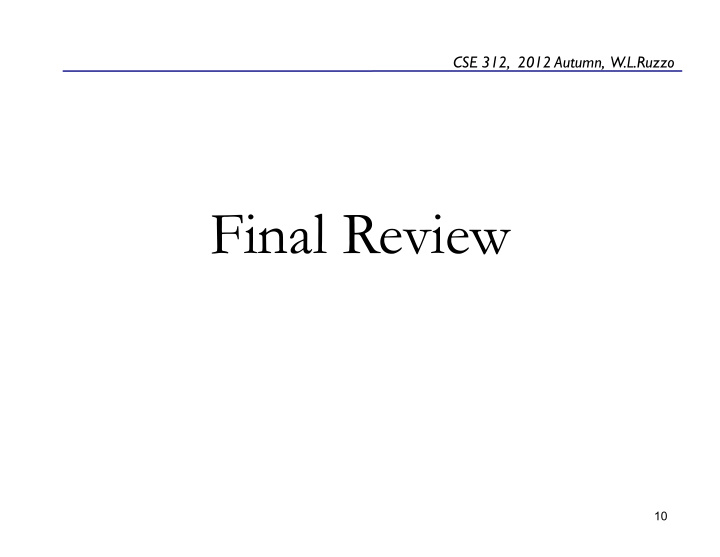



CSE 312, 2012 Autumn, W.L.Ruzzo Final Review 10
general Coverage–comprehensive, slight emphasis post-midterm pre-mid: B&T ch 1-2 post-mid: B&T ch 3,5,9, continuous, limits, hypothesis testing, mle, em. everything in slides, hw, non-supl reading on “Schedule & Reading” web page Mechanics closed book, aside from one page of notes (8.5 x 11, both sides, handwritten) I’m more interested in setup and method than in numerical answers, so concentrate on giving a clear approach, perhaps including a terse english outline of your reasoning. Corollary: calculators are probably irrelevant, but bring one to the exam if you want, just in case. Format–similar to midterm: T/F, multiple choice, problem-solving, explain, … Story problems 11
b&t chapters 1-2 see midterm review slides 12
chapter 3: continuous random variables especially 3.1–3.3; light coverage: 3.4–3.6 probability density function (pdf) cdf as integral of pdf from - ∞ expectation and variance why does variance matter? a simple example: a random X arrives at a server, and chews up f(X) seconds of CPU time. If f(x) is a quadratic or cubic or exponential function, then randomly sampled X’s in the right tail of the distribution can greatly inflate average CPU demand even if rare, so variance (and, more generally, the shape of the distribution) matters a lot, even for a fixed mean. Recall, in general, E[f(X)] ≠ f(E[X]). important examples know pdf and/or cdf, mean, variance of these uniform, normal (incl Φ , “standardization”), exponential 13
b&t chapter 5 tail bounds Markov Chebyshev Chernoff (lightly) limit theorems weak/strong laws of large numbers central limit theorem moment generating functions lightly - see 2-3 slides in “limits” section; skim B&T 4.9 for more 14
likelihood, parameter estimation, MLE (b&t 9.1) likelihood “likelihood” of observed data given a model usually just a product of probabilities (or densities: “lim δ→ 0 … ”) , by independence assumption a function of (unknown?) parameters of the model parameter estimation if you know/assume the form of the model (e.g. normal, poisson,...), can you estimate the parameters based on observed data many ways maximum likelihood estimators one way to do it–choose values of the parameters that maximize likelihood of observed data method (usually) – solve “derivative (wrt parameter/s) of (log) likelihood = 0” 15
expectation maximization (EM) EM iterative algorithm trying to find MLE in situations that are analytically intractable usual framework: there are 0/1 hidden variables (e.g., from which component was this datum sampled) & problem much easier if they were known E-step: given rough parameter estimates, find expected values of hidden variables M-step: given expected values of hidden variables, find (updated) parameter estimates to maximize likelihood Algorithm: iterate above alternately until convergence 16
hypothesis testing (b&t 9.3) I have data, and 2 hypotheses about the process generating it. Which hypothesis is (more likely to be) correct? Again, a very rich literature on this. Here consider the case of 2 simple hypotheses, e.g. p = ½ vs p = ⅔ One of the many approaches: the “Likelihood Ratio Test” likelihood of data under alternate hypothesis H 1 calculate: likelihood of data under null hypothesis H 0 ratio > 1 favors alternate, < 1 favors null, etc. type 1, type 2 error, α , β , etc. Of special interest: α = “significance” - prob of falsely rejecting null when it’s true. 17
significance testing (b&t 9.4) As above: I have data, and 2 hypotheses about the process generating it. Which hypothesis is (more likely to be) correct? But, consider composite hypotheses, e.g., p = ½ vs p ≠ ½ . Can’t do likelihood for composite, so no LRT But can often still evaluate significance : devise a summary statistic whose distribution you can calculate under the null, so you can estimate probability seeing data that cause you to falsely rejecting the null when it’s true. [Very often the stat follows normal- or t-distribution. Thank you, CLT.] p-values: smallest α allowing rejection; probability of generating this data assuming the null is true , not the probability that the null is false. [Note that “Null=T/F” is usually not a probabilistic question, so “prob that null is F” is a nonsensical statement”.] 18
probability & statistics, broadly Noise, uncertainty & variability are pervasive Learning to model it, derive knowledge, and compute despite it are critical E.g., knowing the mean is valuable, but two scenarios with the same mean and different variances can behave very differently in practice. 19
want more? Stat 390/1 probability & statistics CSE 427/8 computational biology CSE 440/1 human/computer interaction CSE 446 machine learning CSE 472 computational linguistics CSE 473 artificial intelligence and others! 20
Thanks and Good Luck! 21
what to expect on the final in more detail ... . 22
Recommend
More recommend